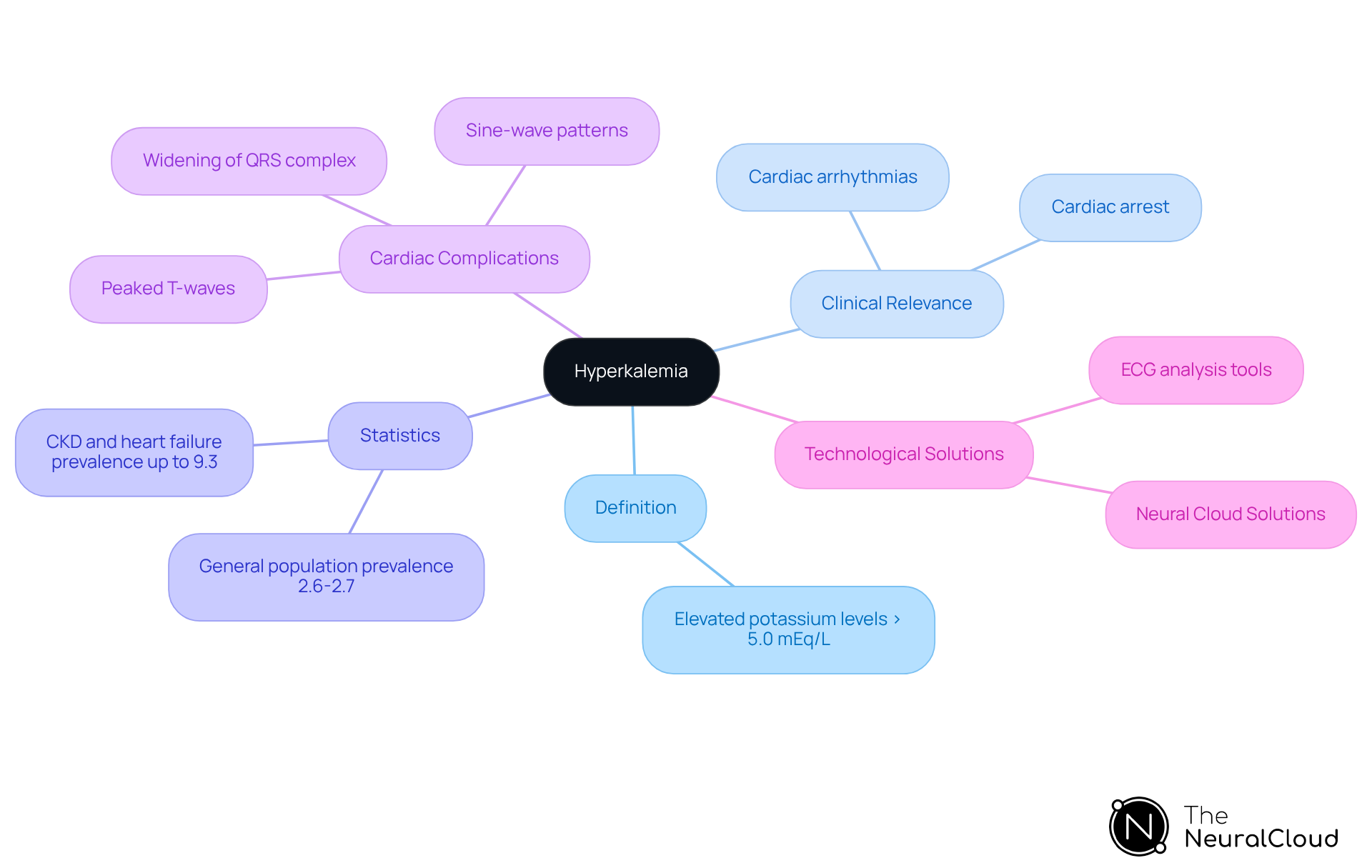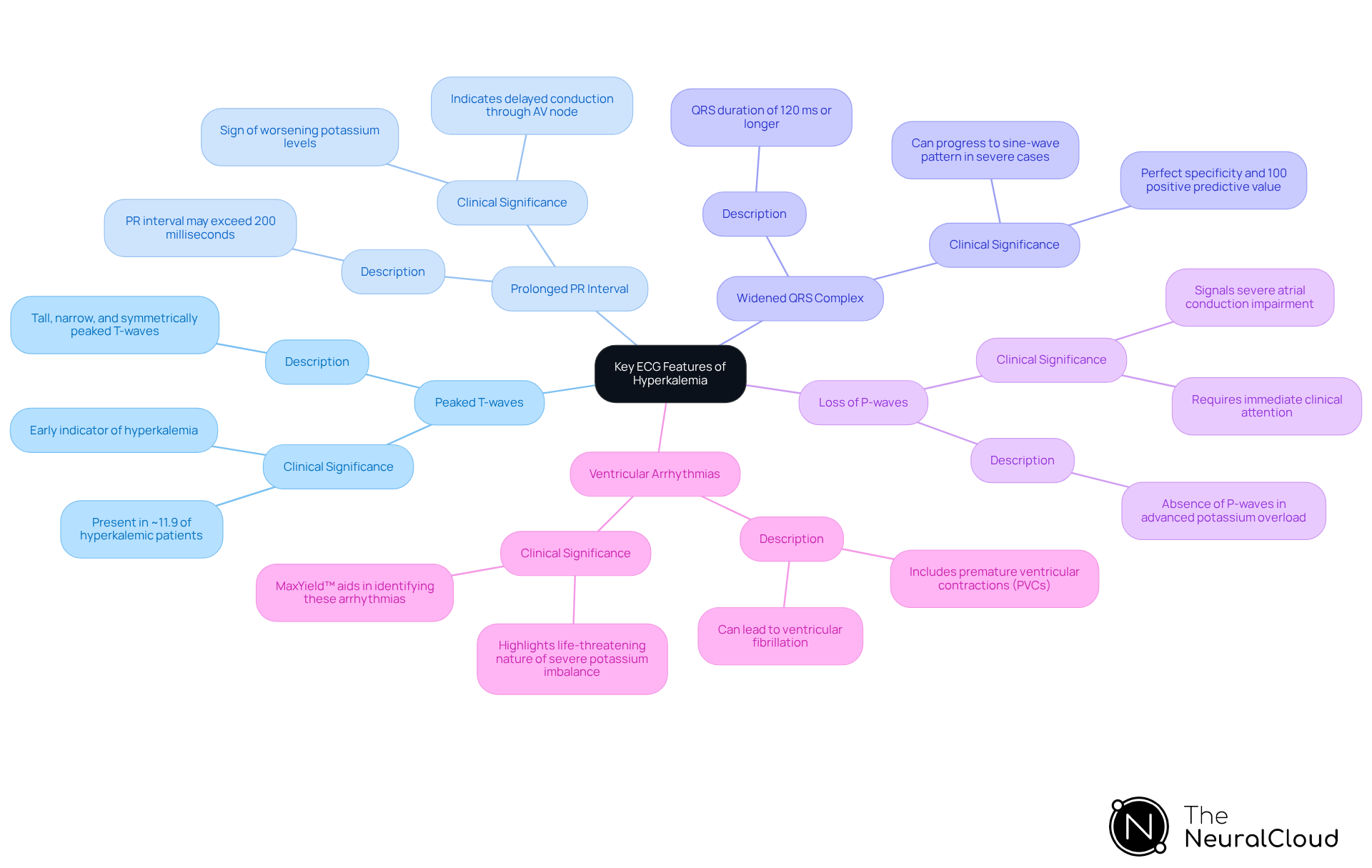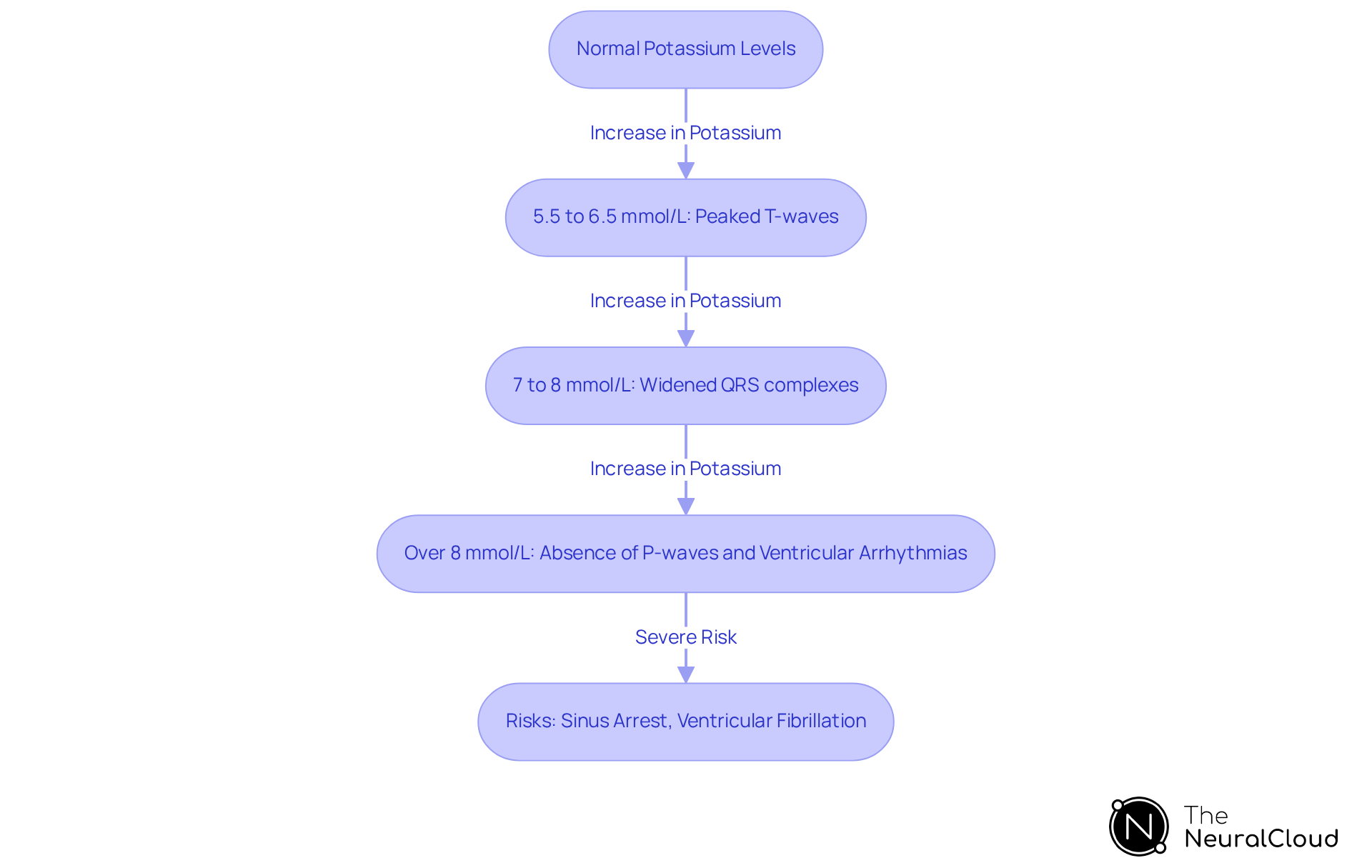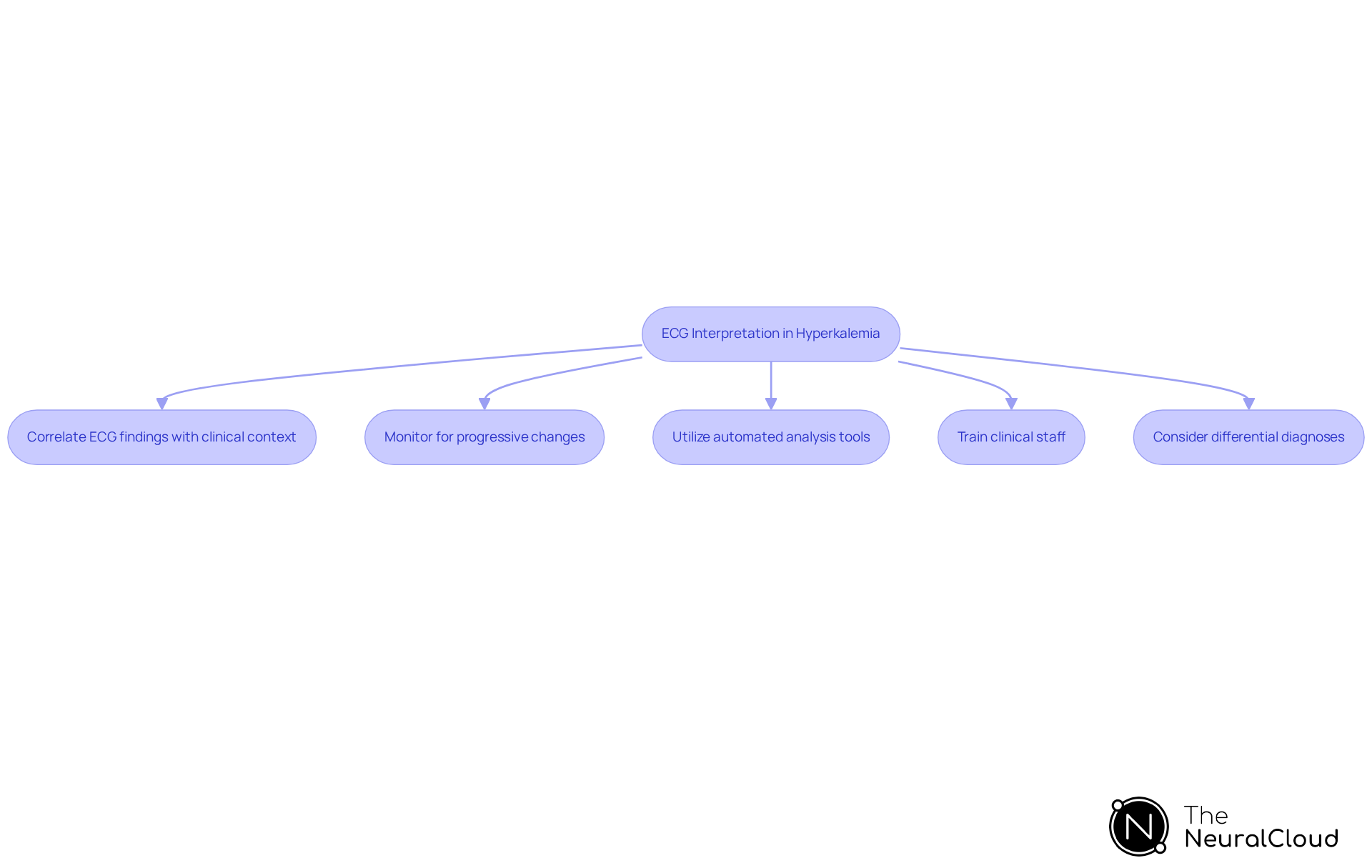Overview
The article provides an overview of the significant EKG changes linked to hyperkalemia and their clinical implications for health tech developers. It highlights the pressing need for advanced ECG analysis tools, such as MaxYield™, to effectively detect and interpret these EKG changes—like peaked T-waves and widened QRS complexes. By enabling timely clinical interventions, these tools can significantly enhance patient outcomes in managing elevated potassium levels.
In the context of ECG analysis, practitioners face challenges in accurately identifying critical changes that can impact patient care. MaxYield™ addresses these challenges by offering advanced features designed to improve the accuracy of ECG readings. Its capabilities include real-time analysis and interpretation of EKG data, which are crucial for healthcare professionals in making informed decisions.
The advantages of utilizing MaxYield™ extend beyond mere detection; they encompass improved workflow efficiency and enhanced clinical decision-making. By integrating this platform into their practices, healthcare professionals can ensure that they are equipped with the tools necessary for effective patient management. The result is a more streamlined approach to handling cases of hyperkalemia, ultimately leading to better patient outcomes.
Introduction
Understanding the complex relationship between potassium levels and cardiac health is crucial for advancing healthcare, particularly in the field of ECG technology.
- Hyperkalemia, characterized by elevated potassium levels in the blood, presents significant risks, including potentially life-threatening arrhythmias and increased healthcare costs.
- As developers of health technology work to improve patient outcomes, they face the challenge of accurately detecting and interpreting the subtle yet critical EKG changes that accompany hyperkalemia.
- Advanced ECG analysis tools can be leveraged to enhance diagnostic accuracy and enable timely interventions in this high-stakes scenario.
Define Hyperkalemia and Its Clinical Relevance
Hyperkalemia is characterized by elevated levels of potassium in the bloodstream, typically defined as a serum concentration exceeding 5.0 mEq/L. This condition is clinically significant due to its potential to cause severe cardiac complications, including arrhythmias and cardiac arrest. The occurrence of elevated potassium levels in the general population is estimated at 2.6-2.7%, with higher rates observed among patients with chronic kidney disease (CKD) and heart failure, where it can reach up to 9.3%.
The connection between hyperkalemia and heart health is essential, as potassium plays a crucial role in regulating cardiac electrical activity. Increased potassium levels can result in hyperkalemia EKG changes, which include:
- Peaked T-waves
- Widening of the QRS complex
- Sine-wave patterns that may precede ventricular fibrillation
These changes highlight the necessity for health tech developers to create ECG analysis tools capable of accurately detecting and interpreting these alterations, facilitating timely clinical interventions.
Case studies emphasize the impact of elevated potassium levels on patient outcomes. For example, individuals with hyperkalemia often experience increased healthcare resource utilization, including higher rates of inpatient admissions and emergency department visits. One study found that patients with hyperkalemia incurred an average of $7,208 higher costs over 30 days compared to those without the condition, underscoring the economic burden associated with its management.
Leading cardiologists stress the importance of monitoring potassium levels, particularly in high-risk populations such as those with CKD, diabetes, and heart failure. They advocate for the incorporation of advanced ECG analysis technologies, like those provided by Neural Cloud Solutions, which can enhance the identification of hyperkalemia EKG changes, ultimately improving patient care and outcomes. Understanding the clinical significance of elevated potassium levels is crucial for health tech developers, as it directly influences the design and functionality of ECG analysis tools aimed at enhancing cardiac health management.

Identify Key ECG Features of Hyperkalemia
The hyperkalemia ekg changes associated with elevated potassium levels are vital for accurate diagnosis and timely intervention. Key features include:
-
Peaked T-waves: Often the earliest indicators of hyperkalemia, these T-waves appear tall, narrow, and symmetrically peaked. Studies indicate that peaked T-waves are present in approximately 11.9% of hyperkalemic patients, underscoring their importance in monitoring. MaxYield™ automates the detection of these T-wave variations, providing rapid insights that enhance clinical decision-making.
-
Prolonged PR interval: As potassium levels rise, the PR interval may exceed 200 milliseconds, reflecting delayed conduction through the atrioventricular node. This change is significant, as it can indicate worsening potassium levels and potential cardiac complications. The advanced algorithms of the MaxYield™ platform swiftly identify these intervals, facilitating timely interventions.
-
Widened QRS complex: Elevated potassium levels can cause a widening of the QRS complex, which may progress to a sine-wave pattern in severe cases. A QRS duration of 120 ms or longer is highly indicative of elevated potassium levels, boasting perfect specificity and a 100% positive predictive value. MaxYield™ enhances the clarity of these readings, ensuring reliable detection mechanisms are integrated into health tech systems.
-
Loss of P-waves: In cases of advanced potassium overload, P-waves may be absent, signaling severe atrial conduction impairment. This absence is concerning and requires immediate clinical attention. The MaxYield™ platform assists in tracking these crucial developments, providing healthcare professionals with essential data for prompt action.
-
Ventricular arrhythmias: These can present as premature ventricular contractions (PVCs) or even ventricular fibrillation in critical cases, highlighting the life-threatening nature of severe potassium imbalance. MaxYield™ supports the identification of these arrhythmias through its automated analysis, ensuring healthcare providers are alerted to potential emergencies.
While ECG variations are significant, the clinical utility of these parameters may be limited due to low sensitivity and specificity. For instance, 24% of normokalemic patients exhibited ECG changes suggestive of hyperkalemia ekg changes, emphasizing the risk of misdiagnosis and the need for careful analysis of ECG variations. By integrating MaxYield™ into their platforms, health tech developers can enhance diagnostic accuracy and facilitate timely interventions, ultimately improving patient outcomes in emergency settings.

Explain the Pathophysiology Behind ECG Changes
Hyperkalemia interferes with normal cardiac electrical activity primarily due to increased extracellular ion levels, significantly altering the resting membrane potential of cardiac myocytes. This change results in increased excitability and modified conduction velocity, leading to hyperkalemia EKG changes.
Initially, peaked T-waves appear due to rapid ventricular repolarization, which are considered hyperkalemia EKG changes when electrolyte levels range between 5.5 and 6.5 mmol/L. As potassium concentrations rise, the action potential duration decreases, which contributes to this phenomenon.
Impaired conduction through the atrioventricular node, which is particularly sensitive to fluctuations in certain electrolytes, leads to prolonged PR intervals. This serves as a critical indicator of the heart's response to elevated potassium levels.
Widened QRS complexes, observed at electrolyte levels of 7-8 mmol/L, are indicative of hyperkalemia EKG changes that signify delayed ventricular depolarization due to slowed conduction through the His-Purkinje system. This widening directly results from elevated extracellular ion levels, disrupting the heart's electrical conduction pathways.
In severe cases of elevated potassium levels, hyperkalemia EKG changes like the absence of P-waves and the emergence of ventricular arrhythmias indicate a substantial compromise in the heart's electrical stability. These changes can lead to life-threatening conditions such as sinus arrest or ventricular fibrillation, particularly when potassium levels exceed 8 mmol/L, where a sine wave pattern may also be noted.
For developers, understanding these mechanisms is crucial for creating algorithms that accurately reflect the physiological changes associated with elevated potassium levels. The integration of Neural Cloud Solutions' MaxYield™ platform significantly enhances diagnostic capabilities by automating ECG analysis and employing advanced noise filtering techniques. MaxYield™ offers beat-by-beat analysis, processing up to 200,000 heartbeats in less than 5 minutes, facilitating rapid isolation of critical ECG features, even in recordings with high levels of noise and artifact. This ultimately improves patient outcomes.
It is important to note that the sensitivity of ECG diagnosis for elevated potassium levels ranges from 0.34 to 0.43, underscoring the diagnostic challenges. Additionally, atrial tissues are more responsive to elevated potassium levels than other cardiac tissues, and malfunctioning of implanted pacemakers can occur, as evidenced by widening of the paced QRS complex and failure to capture atrial and ventricular pacing.

Apply Practical Tips for ECG Interpretation in Hyperkalemia
When interpreting ECGs in patients with suspected hyperkalemia EKG changes, it is essential to apply practical strategies.
-
Correlate ECG findings with clinical context: Always evaluate the patient's medical history, symptoms, and laboratory results to verify elevated potassium levels. This holistic approach ensures accurate diagnosis and treatment.
-
Monitor for progressive changes: Regularly review ECGs over time, as potassium levels can cause evolving changes. Early identification of peaked T-waves is crucial, as it may signify hyperkalemia EKG changes that indicate worsening potassium levels.
-
Utilize automated analysis tools: Employ sophisticated algorithms, like those present in MaxYield™, capable of identifying unusual ECG characteristics linked to elevated potassium levels. MaxYield™ transforms lengthy and noisy ECG recordings into clean, crisp signals, significantly enhancing clinical response times. AI models within MaxYield™ have achieved a detection accuracy of 96-97% in identifying irregular heart rhythms, making it an invaluable tool for healthcare professionals.
-
Train clinical staff: Provide instruction for healthcare professionals to identify elevated potassium levels on ECGs. This education is vital for improving patient care and ensuring timely interventions.
-
Consider differential diagnoses: Be vigilant about other conditions that may present similarly on an ECG, such as myocardial ischemia or other electrolyte imbalances. Understanding these nuances is crucial for accurate diagnosis.
By integrating these strategies and leveraging the capabilities of MaxYield™, health tech developers can enhance the effectiveness of their ECG analysis tools, ultimately leading to improved patient outcomes in the management of hyperkalemia and addressing hyperkalemia EKG changes.

Conclusion
Understanding hyperkalemia and its impact on cardiac health is essential for health tech developers aiming to enhance patient care. This article has explored the critical relationship between elevated potassium levels and EKG changes, emphasizing the necessity for accurate detection and interpretation of these alterations. By developing advanced ECG analysis tools, the healthcare industry can significantly improve clinical outcomes for patients at risk of hyperkalemia.
Key insights highlighted include the specific EKG features associated with hyperkalemia, such as:
- Peaked T-waves
- Prolonged PR intervals
- Widened QRS complexes
These changes serve as vital indicators of potassium imbalance and underscore the importance of timely intervention. Additionally, the pathophysiology behind these EKG variations illustrates how increased potassium levels disrupt normal cardiac electrical activity, leading to potentially life-threatening conditions. Practical strategies for ECG interpretation further enhance the ability to accurately diagnose and manage hyperkalemia effectively.
The implications of this knowledge extend beyond individual patient care; they underscore the broader significance of integrating advanced technologies in healthcare. As the prevalence of hyperkalemia continues to rise, particularly among vulnerable populations, the development and implementation of sophisticated ECG analysis tools will be crucial. Health tech developers are encouraged to prioritize these innovations to ensure that the healthcare system can respond effectively to the challenges posed by hyperkalemia and improve overall patient outcomes.
Frequently Asked Questions
What is hyperkalemia?
Hyperkalemia is a condition characterized by elevated levels of potassium in the bloodstream, typically defined as a serum potassium concentration exceeding 5.0 mEq/L.
Why is hyperkalemia clinically significant?
Hyperkalemia is clinically significant due to its potential to cause severe cardiac complications, including arrhythmias and cardiac arrest.
What is the prevalence of hyperkalemia in the general population?
The occurrence of elevated potassium levels in the general population is estimated at 2.6-2.7%, with higher rates observed among patients with chronic kidney disease (CKD) and heart failure, where it can reach up to 9.3%.
How does hyperkalemia affect heart health?
Increased potassium levels can disrupt cardiac electrical activity, leading to hyperkalemia EKG changes, such as peaked T-waves, widening of the QRS complex, and sine-wave patterns that may precede ventricular fibrillation.
What are the implications of hyperkalemia on healthcare resources?
Individuals with hyperkalemia often experience increased healthcare resource utilization, including higher rates of inpatient admissions and emergency department visits. One study found that patients with hyperkalemia incurred an average of $7,208 higher costs over 30 days compared to those without the condition.
Who is at higher risk for developing hyperkalemia?
High-risk populations for developing hyperkalemia include individuals with chronic kidney disease (CKD), diabetes, and heart failure.
What do cardiologists recommend for managing hyperkalemia?
Leading cardiologists emphasize the importance of monitoring potassium levels, particularly in high-risk populations, and advocate for the use of advanced ECG analysis technologies to enhance the identification of hyperkalemia EKG changes, improving patient care and outcomes.






